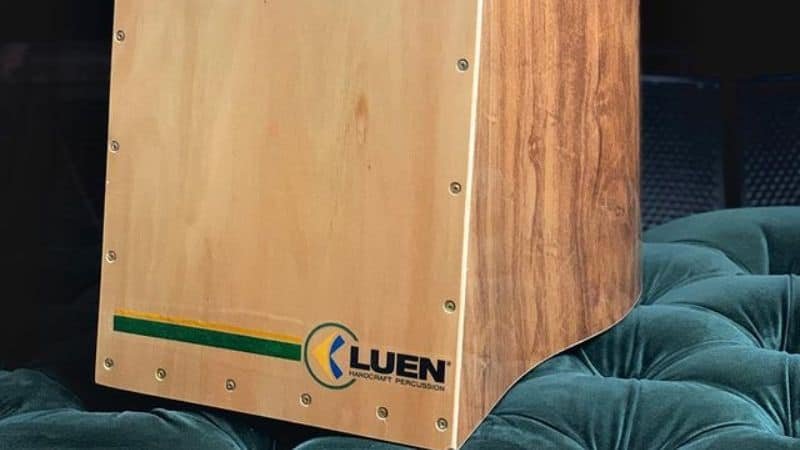How to Play Cajon? – Complete Review

When it comes to rhythm, a good cajon is essential. It is a percussion instrument, and as such, it provides the backbone for any band or musician. Without a good cajon, the band would sound lost and directionless. It provides the perfect foundation for the other instruments to build upon.
In addition to rhythm, a good cajon can also add a unique flavor to a band’s sound. It can be used to create a wide range of sounds, from simple beats to complex rhythms. By experimenting with different techniques, a good cajon player can add a great deal of variety to a band’s sound.
What Is Cajon?
Contents
A cajon (pronounced ka-HONE) is a type of box drum that originates from Peru. It is typically played with the hands, although sticks or other mallets can also be used. The cajon has a wide range of sounds that can be produced, from a simple bass thump to a complex array of percussion rhythms.
Sitting box drum is a versatile instrument that can be used in a variety of musical genres, from folk to rock to jazz. It is also a popular choice for acoustic solo performers, as it can provide a wide range of sounds without the need for other instruments.

Types of Cajon
There are many different types of cajon on the market:
- Acoustic cajon: These cajons are made of wood and produce a natural, acoustic sound. They are the most popular type of cajon and are great for all types of music.
- Electric cajon: These cajons are made of wood or plastic and have an amplifier and speaker built-in. They are great for adding a little extra volume and punch to your sound.
- Percussion cajon: These cajons are made of wood or plastic and have a variety of different percussion elements built-in, such as snares, cymbals, and tambourines. They are great for adding a more diverse sound to your music.
- Portable cajon: These cajons are small and lightweight, making them easy to transport. They are great for practice or for taking to gigs.
- Kid’s cajon: These cajons are smaller in size and are specifically designed for kids. They are a great way to get your child interested in music.
Cajon: How to Play?
Posture
When sitting on the cajon, it is important to make sure that your spine is in a neutral position, with your head, neck, and shoulders aligned. You may find it helpful to sit up tall and elongate your spine, keeping your abdominal muscles pulled in. This will help you to stay balanced and avoid tension in your neck and shoulders.
Some players prefer to rest their arms on the cajon while playing, while others find it more comfortable to let their arms hang loose by their sides. Experiment with different positions to see what feels best for you.
It is also important to make sure that your feet are positioned correctly. You should be sitting with your heels resting on the edge of the cajon, with your toes pointing slightly outwards. This will help you to stay balanced and create a strong foundation for your playing.
With a little experimentation, you will be able to find the posture that works best for you and allows you to play the cajon with ease and comfort.
Strokes
To make a sound, you will need to use different strokes. The four main strokes are the downstroke, upstroke, flamenco stroke, and rumba stroke.
The downstroke is the most common stroke and is made by striking the tapa with your dominant hand and then the caja with your non-dominant hand.
The upstroke is made by striking the caja with your dominant hand and then the tapa with your non-dominant hand.
The flamenco stroke is made by striking the tapa with your non-dominant hand and then the caja with your dominant hand.
The rumba stroke is made by striking the caja with your non-dominant hand and then the tapa with your dominant hand.
Once you know the four main strokes, you can start to experiment with different rhythms and patterns. There are many different ways to play the cajon, so have fun and be creative!

Sound
The cajon can produce a wide range of sounds, from simple rhythms to complex polyrhythms. The most basic sound is produced by striking the front of the cajon with the hand. This produces a sharp, percussive sound. The box drums can also produce a range of tones by striking different parts of the front panel with the hand. For example, striking the center of the panel produces a deep bass tone, while striking the edges produces a high-pitched tone.
The cajon can also produce a variety of sounds by using different techniques. For example, the player can produce a rolling sound by striking the front of the cajon with the hand and then quickly moving the hand across the surface. The player can also create a “snare” sound by striking the front and back panels simultaneously.
The cajon can also be played with a variety of percussion instruments. For example, the player can use a drumstick to produce a variety of sounds on the cajon. The player can also use a variety of other percussion instruments, such as cymbals, to create a more complex sound.
Tons
The cajon beats can be played with a variety of tones, depending on the way that it is played:
- The bass tone of the cajon is created by striking the front panel of the instrument with the hands. This creates a low-pitched tone that is similar to the sound of a bass drum. The bass tone of the cajon can be used to create a strong rhythm for the music.
- The high tone of the cajon is created by striking the front panel of the instrument with the fingers. This creates a high-pitched tone that is similar to the sound of a snare drum. The high tone of the cajon can be used to create a light and airy sound for the music.
Guide: How to Play Box Drum?
Step 1
Choose the cajon that is right for you. There are many different sizes and shapes of cajons, so it is important to find one that is comfortable for you to play.
Step 2
Learn the basic cajon rhythms. There are many different rhythms that can be played on the cajon, so it is important to learn the basics before trying to play more complicated rhythms.
Step 3
Experiment with different sounds. The cajon can be played with a variety of different sounds, so it is important to experiment to find the sounds that you are most comfortable with.
Step 4
Practice, practice, practice. The more you practice, the better you will become at playing the cajon.

Guide: How To Play A Cajon With Sticks?
In order to play a cajon with sticks, you will need a pair of drumsticks and a cajon. Sit on the cajon so that the front panel is facing you and place your sticks in your lap. Use your dominant hand to hold one stick and your other hand to hold the other stick.
Strike the front panel of the cajon with your dominant hand. Use different strokes to create different sounds. Experiment with different rhythms and speeds. You can also use your non-dominant hand to play the cajon by striking the side panels.
Guide: How To Read Cajon Notes?
When reading cajon notes, it is important to first understand the layout of the cajon. There are typically two sets of notes on a cajon – the bass notes and the treble notes. The bass notes are located on the front of the cajon, and the treble notes are located on the back of the cajon.
To play the bass notes, place your hand on the front of the cajon and play the notes with your fingers. To play the treble notes, place your hand on the back of the cajon and play the notes with your fingers.
Tips: How to Place the Hand to Get a Better Sound on Cajon?
Some tips to help place your hands for a better sound on cajon include:
- Finding the sweet spot: This is the spot on the cajon where your hands sound best. experiment with different spots on the cajon until you find the spot that gives you the sound you’re looking for.
- Placing your hands parallel to the front of the cajon: This will help you to achieve a deeper sound.
- Placing your hands at a slight angle: This will help you to achieve a brighter sound.

Frequently Asked Question
Can a Cajon Replace a Drum Kit?
A cajon can be used as an alternative to a drum kit, but it does not provide the same range of sounds. A cajon is a box-shaped percussion instrument that is played by slapping the front and back surfaces. It has a deep, resonant sound that is perfect for Latin rhythms. A drum kit, on the other hand, consists of a bass drum, a snare drum, tom-toms, and cymbals. It is ideal for rock and jazz music.
Is Cajon Easy to Play?
Cajon is one of the easiest instruments to play. It is a box-shaped percussion instrument that you can play with your hands.

How Do You Amplify a Cajon Drum?
There are a few ways to amplify a cajon drum. One way is to use a microphone. Another way is to use an amplifier.
Can You Tune A Cajon?
Yes, you can tune a cajon! Here is a guide on how to do so:
- Find the tuning screws on the back of the cajon.
- Using a tuning key or a drill, turn the screws to adjust the tension of the drumhead.
- Tune the cajon to your desired pitch.
- Play around and experiment with the different sounds that you can create!
Conclusion
A good cajon is also a versatile instrument. It can be used to play a wide range of genres, from traditional folk music to modern rock. Cajon players can fit in well with any band or style of music.
Playing cajon is simply fun! There’s something about the simple act of hitting a drum that is both satisfying and addictive. The drum box instrument is perfect for anyone who wants to explore their musical side.

